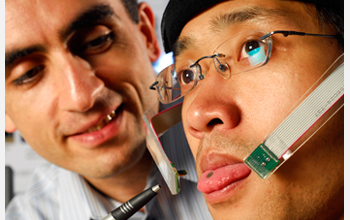 Maysam Ghovanloo (left) points to a small magnet attached to graduate student Xueliang Huo's tongue. |
Using only tongue motions, individuals with paralyzed limbs may be able to use new system to take control of technology
Researchers have developed an experimental tongue-based system that may allow individuals with debilitating disabilities to control wheelchairs, computers and other devices with relative ease and no sophistication.
Because the tongue is directly connected to the brain via cranial nerves, it usually remains mobile when other body parts lose function to disease or accidents. That mobility underlies the new system, which may one day provide greater flexibility and simplicity to individuals who would otherwise use sip-and-puff controls or brain implants.
Electrical engineer Maysam Ghovanloo developed the Tongue Drive system in collaboration with graduate student Xueliang Huo and presented the findings June 29 at the 2008 Rehabilitation Engineering and Assistive Technology Society of North America (RESNA) Annual Conference in Washington, D.C.
"Tongue Drive is inherently wireless and touch-free because it relies on a tiny magnetic tracer attached to the tongue with no power consumption," said Ghovanloo. "Tongue movements are also fast, accurate and do not require much thinking, concentration or effort."Developed with funding from the National Science Foundation and additional support from the Christopher and Dana Reeve Foundation, the technology is already showing speed and flexibility that rivals or surpasses other technologies.
For further details regarding the Tongue Drive, see the Georgia Tech press release at: http://gtresearchnews.gatech.edu/newsrelease/tongue-drive.htm.










